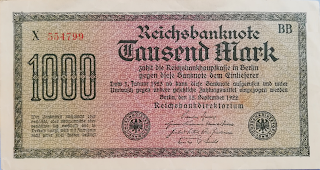In September 1922, a new 1000 RM is issued, smaller then the previous ones.
 |
| German Reich - Pick 76 |
In the chart below (pic from Pick's catalogue), we see some of the possible watermarks.
This 1000 RM note can have 8 possible watermark variations.
76a (E) - 76b (I) - 76c (F) - 76d (D) - 76e (G) - 76f (H) - 76g (J) - 76h (K)
 |
| 3 different watermarks: I - D and G |
 |
| 5 different types of notes (Pick 75) |
The note with watermark G, has Gd as serial letter and a green serial number, here also an asterisk.
The 3 notes with red serials numbers all have the I watermark (but random serial letters);
the notes above also have 3 styles in serial numbers one with an asterisk, one without and a third one written in a different lettertype.
Pick mentiones watermark I on yellow paper, J and K on greenish paper and the others on white paper.
In this third emission of 1922, two different 5000 RM are issued too. These notes are quit valuable.
As the value of each notes drops dramatically, the face value keeps increasing and the quality of the printing drops. More and more notes are needed for the population, so printing becomes a non-stop activity of that Reichsbank. To prevent that people need bundles of banknotes to pay basic products, each new series of notes is a multiple of the value of the previous series ...
to be continued ...

No comments:
Post a Comment